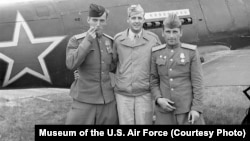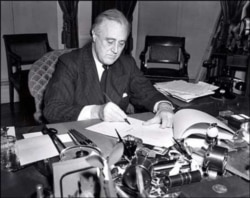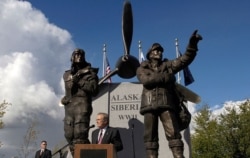On February 24, 1943, a Douglas C-47 Skytrain transport aircraft with serial number 42-32892 rolled out of a factory in Long Beach, California, and was handed over to the U.S. Air Force.
On March 12, 1943, the plane was given to the Soviet Air Force in Fairbanks, Alaska, and given the registration USSR-N238. From there, it flew 5,650 kilometers to the Siberian city of Krasnoyarsk, one of some 14,000 aircraft sent by the United States to the Soviet Union during World War II under the massive Lend-Lease program.
This particular C-47 was sent to the Far North and spent the war conducting reconnaissance and weather-monitoring missions over the Kara Sea. After the war, it was transferred to civilian aviation, carrying passengers over the frozen tundra above the Arctic Circle. On April 23, 1947, it was forced to make an emergency landing with 36 people on board near the village of Volochanka on the Taimyr Peninsula.
On May 11, 1947, 27 people were rescued, having spent nearly three weeks in the icebound wreck. The captain, two crew members, and six passengers had left earlier in an ill-fated effort to get help. The body of the captain, Maksim Tyurikov, was found by local hunters about 120 kilometers from the wreck in 1953. The others were never found.
The plane spent 69 years on the tundra before a Russian Geographical Society expedition rescued it in 2016 and returned the wreckage to Krasnoyarsk.
"I knew that its place was in a museum," Vyacheslav Filippov, a colonel in the Russian Air Force reserve who has written extensively about the Lend-Lease program's Siberian connection, told RFE/RL at the time. "It was not just some piece of scrap metal. It is our living history. This Douglas is the only Lend-Lease aircraft that remains in Russia."
An estimated 25 million Soviet citizens perished in the titanic conflict with Nazi Germany between June 1941 and May 1945. Overcoming massive defeats and colossal losses over the first 18 months of the war, the Red Army was able to reorganize and rebuild to form a juggernaut that marched all the way to Berlin. But the Soviet Union was never alone: Months before the United States formally entered the war, it had already begun providing massive military and economic assistance to its Soviet ally through the Lend-Lease program.
From the depths of the Cold War to the present day, many Soviet and Russian politicians have ignored or downplayed the impact of American assistance to the Soviets, as well as the impact of the entire U.S.-British war against the Nazis.
A Soviet report by Politburo member Nikolai Voznesensky in 1948 asserted that the United States, described as "the head of the antidemocratic camp and the warrior of imperialist expansion around the world," contributed materiel during the war that amounted to just 4.8 percent of the Soviet Union's own wartime production.
The Short History Of The Great Patriotic War, also from 1948, acknowledged the Lend-Lease shipments, but concluded: "Overall this assistance was not significant enough to in any way exert a decisive influence over the course of the Great Patriotic War."
Nikolai Ryzhkov, the last head of the government of the Soviet Union, wrote in 2015 that "it can be confidently stated that [Lend-Lease assistance] did not play a decisive role in the Great Victory."
Such assessments, however, are contradicted by the opinions of Soviet war participants. Most famously, Soviet dictator Josef Stalin raised a toast to the Lend-Lease program at the November 1943 Tehran conference with British Prime Minister Winston Churchill and U.S. President Franklin Roosevelt.
"I want to tell you what, from the Russian point of view, the president and the United States have done for victory in this war," Stalin said. "The most important things in this war are the machines.... The United States is a country of machines. Without the machines we received through Lend-Lease, we would have lost the war."
Nikita Khrushchev offered the same opinion.
"If the United States had not helped us, we would not have won the war," he wrote in his memoirs. "One-on-one against Hitler's Germany, we would not have withstood its onslaught and would have lost the war. No one talks about this officially, and Stalin never, I think, left any written traces of his opinion, but I can say that he expressed this view several times in conversations with me."
The Lend-Lease act was enacted in March 1941 and authorized the United States to provide weapons, provisions, and raw materials to strategically important countries fighting Germany and Japan -- primarily, the United Kingdom, the Soviet Union, and China. In all, the United States shipped $50 billion ($608 billion in 2020 money) worth of materiel under the program, including $11.3 billion to the Soviet Union. In addition, much of the $31 billion worth of aid sent to the United Kingdom was also passed on to the Soviet Union via convoys through the Barents Sea to Murmansk.
Most visibly, the United States provided the Soviet Union with more than 400,000 jeeps and trucks, 14,000 aircraft, 8,000 tractors and construction vehicles, and 13,000 battle tanks.
However, the real significance of Lend-Lease for the Soviet war effort was that it covered the "sensitive points" of Soviet production -- gasoline, explosives, aluminum, nonferrous metals, radio communications, and so on, says historian Boris Sokolov.
"In a hypothetical battle one-on-one between the U.S.S.R and Germany, without the help of Lend-Lease and without the diversion of significant forces of the Luftwaffe and the German Navy and the diversion of more than one-quarter of its land forces in the fight against Britain and the United States, Stalin could hardly have beaten Hitler," Sokolov wrote in an essay for RFE/RL's Russian Service.
Under Lend-Lease, the United States provided more than one-third of all the explosives used by the Soviet Union during the war. The United States and the British Commonwealth provided 55 percent of all the aluminum the Soviet Union used during the war and more than 80 percent of the copper.
Lend-Lease also sent aviation fuel equivalent to 57 percent of what the Soviet Union itself produced. Much of the American fuel was added to lower-grade Soviet fuel to produce the high-octane fuel needed by modern military aircraft.
The Lend-Lease program also provided more than 35,000 radio sets and 32,000 motorcycles. When the war ended, almost 33 percent of all the Red Army's vehicles had been provided through Lend-Lease. More than 20,000 Katyusha mobile multiple-rocket launchers were mounted on the chassis of American Studebaker trucks.
In addition, the Lend-Lease program propped up the Soviet railway system, which played a fundamental role in moving and supplying troops. The program sent nearly 2,000 locomotives and innumerable boxcars to the Soviet Union. In addition, almost half of all the rails used by the Soviet Union during the war came through Lend-Lease.
"It should be remembered that during World War I, the transportation crisis in Russia in 1916-17 that did a lot to facilitate the February Revolution [which lead to the abdication of the tsar] was caused by a shortage in the production of railway rails, engines, and freight cars because industrial production had been diverted to munitions," Sokolov wrote. "During World War II, only the supplies brought in by Lend-Lease prevented the paralysis of rail transport in the Soviet Union."
The Lend-Lease program also sent tons of factory equipment and machine tools to the Soviet Union, including more than 38,000 lathes and other metal-working tools. Such machines were of higher quality than analogues produced in the Soviet Union, which made a significant contribution to boosting Soviet industrial production.
American aid also provided 4.5 million tons of food, 1.5 million blankets, and 15 million pairs of boots.
"In order to really assess the significance of Lend-Lease for the Soviet victory, you only have to imagine how the Soviet Union would have had to fight if there had been no Lend-Lease aid," Sokolov wrote. "Without Lend-Lease, the Red Army would not have had about one-third of its ammunition, half of its aircraft, or half of its tanks. In addition, there would have been constant shortages of transportation and fuel. The railroads would have periodically come to a halt. And Soviet forces would have been much more poorly coordinated with a constant lack of radio equipment. And they would have been perpetually hungry without American canned meat and fats."
In 1963, KGB monitoring recorded Soviet Marshal Georgy Zhukov saying: "People say that the allies didn't help us. But it cannot be denied that the Americans sent us materiel without which we could not have formed our reserves or continued the war. The Americans provided vital explosives and gunpowder. And how much steel! Could we really have set up the production of our tanks without American steel? And now they are saying that we had plenty of everything on our own."











